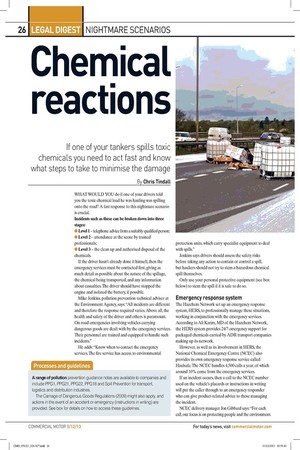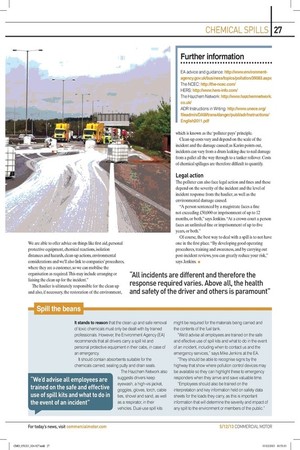Chemical reactions
Page 17

Page 18

If you've noticed an error in this article please click here to report it so we can fix it.
If one of your tankers spills toxic chemicals you need to act fast and know what steps to take to minimise the damage By Chris Tindall
WHAT WOULD YOU do if one of your drivers told you the toxic chemical load he was hauling was spilling onto the road? A fast response to this nightmare scenario is crucial. Incidents such as these can be broken down into three stages: • Level I— telephone advice from a suitably qualified person; • Level 2— attendance at the scene by trained professionals;
• Level 3 — the clean up and authorised disposal of the chemicals.
If the driver hasn't already done it himself, then the emergency services must be contacted first, giving as much detail as possible about the nature of the spillage, the chemical being transported, and any information about casualties. The driver should have stopped the engine and isolated the battery, if possible.
Mike Jenkins, pollution prevention technical adviser at the Environment Agency, says: "All incidents are different and therefore the response required varies. Above all, the health and safety of the driver and others is paramount. On-road emergencies involving vehicles carrying dangerous goods are dealt with by the emergency services. Their personnel are trained and equipped to handle such incidents." He adds: "Know when to contact the emergency services. The fire service has access to environmental
protection units, which carry specialist equipment to deal with spills."
Jenkins says drivers should assess the safety risks before taking any action to contain or control a spill, but hauliers should not try to stem a hazardous chemical spill themselves.
Only use your personal protective equipment (see box below) to stem the spill if it is safe to do so. Emergency response system
The Hazchem Network set up an emergency response system, HERS, to professionally manage these situations, working in conjunction with the emergency services. According to Ali Karim, MD of the Hazchem Network, the HERS system provides 24/7 emergency support for packaged chemicals carried by ADR transport companies making up its network.
However, as well as its involvement in HERS, the National Chemical Emergency Centre (NCEC) also provides its own emergency response service called Haulsafe. The NCEC handles 4,500 calls a year, of which around 10% come from the emergency services.
If an incident occurs, then a call to the NCEC number used on the vehicle's placards or instructions in writing will put the caller through to an emergency responder who can give product-related advice to those managing the incident.
NCEC delivery manager Jon Gibbard says: "For each call, our focus is on protecting people and the environment.
We are able to offer advice on things like first aid, personal protective equipment, chemical reactions, isolation distances and hazards, clean-up actions, environmental considerations and we'll also link to companies' procedures, where they are a customer, so we can mobilise the organisation as required. This may include arranging or liaising the clean up for the incident." The haulier is ultimately responsible for the clean up and also, if necessary, the restoration of the environment,
which is known as the 'polluter pays' principle.
Clean-up costs vary and depend on the scale of the incident and the damage caused; as Karim points out, incidents can vary from a drum leaking due to nail damage from a pallet all the way through to a tanker rollover. Costs of chemical spillages are therefore difficult to quantify. Legal action
The polluter can also face legal action and fines and these depend on the severity of the incident and the level of incident response from the haulier, as well as the environmental damage caused.
"A person sentenced by a magistrate faces a fine not exceeding £50,000 or imprisonment of up to 12 months, or both," says Jenkins "At a crown court a person faces an unlimited fine or imprisonment of up to five years, or both." Of course, the best way to deal with a spill is to not have one in the first place. "By developing good operating procedures, training and awareness, and by carrying out post-incident reviews, you can greatly reduce your risk," says Jenkins. •
Processes and guidelines
A range of pollution prevention guidance notes are available to companies and include PPG1, PPG21, PPG22, PPG18 and Spill Prevention for transport, logistics and distribution industries.
The Carriage of Dangerous Goods Regulations (2009) might also apply, and actions in the event of an accident or emergency (instructions in writing) are provided. See box for details on how to access these guidelines.
Further information
EA advice and guidance: napwwww.environmentagency.gov.uk/businessitopics/pollution/39083.aspx The NCEC: http:/Ahe-ncec.com/ HERS: http://www.hers-info.com/ The Hazchem Network: http://www.hazchemnetwork. co.uW ADR Instructions in Writing: http://www.unece.org/ fileadmin/DAWtrans/danger/publi/adrAnstructions/ English2011.pdf




































